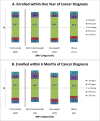A diagnosis of prostate cancer and pursuit of active surveillance is not followed by weight loss: potential for a teachable moment
- PMID: 27431498
- PMCID: PMC5564326
- DOI: 10.1038/pcan.2016.28
A diagnosis of prostate cancer and pursuit of active surveillance is not followed by weight loss: potential for a teachable moment
Abstract
Background: Obesity is a risk factor for incident prostate cancer (PC) as well as risk of disease progression and mortality. We hypothesized that men diagnosed with lower-risk PC and who elected active surveillance (AS) for their cancer management would likely initiate lifestyle changes that lead to weight loss.
Methods: Patients were enrolled in the Prostate Active Surveillance Study (PASS), a multicenter prospective biomarker discovery and validation study of men who have chosen AS for their PC. Data from 442 men diagnosed with PC within 1 year of study entry who completed a standard of care 12-month follow-up visit were analyzed. We examined the change in weight and body mass index (BMI) over the first year of study participation.
Results: After 1 year on AS, 7.5% (33/442) of patients had lost 5% or more of their on-study weight. The proportion of men who lost 5% or more weight was similar across categories of baseline BMI: normal/underweight (8%), overweight (6%) and obese (10%, χ2 test P=0.44). The results were similar for patients enrolled in the study 1 year or 6 months after diagnosis. By contrast, after 1 year, 7.7% (34/442) of patients had gained >5% of their weight.
Conclusions: Only 7.5% of men with low-risk PC enrolled in AS lost a modest (⩾5%) amount of weight after diagnosis. Given that obesity is related to PC progression and mortality, targeted lifestyle interventions may be effective at this 'teachable moment', as men begin AS for low-risk PC.
Conflict of interest statement
The authors declare no competing financial interests in relation to the work described in this manuscript.
Figures

References
-
- Bill-Axelson A, Holmberg L, Ruutu M, Garmo H, Stark JR, Busch C, et al. Radical prostatectomy versus watchful waiting in early prostate cancer. The New England journal of medicine. 2011;364(18):1708–1717. - PubMed
-
- Klotz L, Vesprini D, Sethukavalan P, Jethava V, Zhang L, Jain S, et al. Long-term follow-up of a large active surveillance cohort of patients with prostate cancer. J Clin Oncol. 2015;33(3):272–277. - PubMed
-
- Bhindi B, Kulkarni GS, Finelli A, Alibhai SM, Hamilton RJ, Toi A, et al. Obesity Is Associated with Risk of Progression for Low-risk Prostate Cancers Managed Expectantly. European urology. 2014 - PubMed
Publication types
MeSH terms
Grants and funding
LinkOut - more resources
Full Text Sources
Other Literature Sources
Medical
Research Materials

